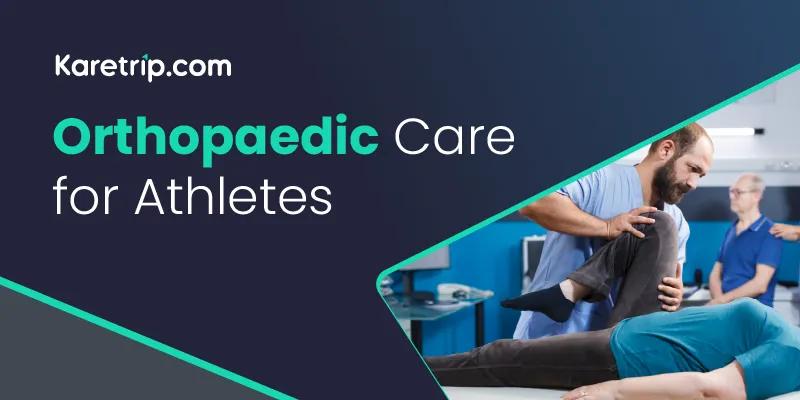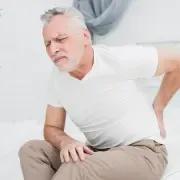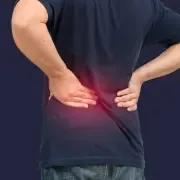Orthopaedic Care for Athletes
In This Article
Orthopaedic Care for Athletes
Pooja
Updated on November 26, 2024
Medically verified by Dr. Arya
Fact checked by Dr. Fazeela

Orthopaedics
10 minutes
Orthopaedic care is essential for athletes to maintain optimal performance, reduce injury risks, and recover effectively from injuries.
Understanding the role of orthopaedics in sports medicine is crucial for achieving long-term success.
This blog by Karetrip delves into orthopaedic care for athletes, highlighting injury prevention, treatment strategies, rehabilitation, and the latest innovations in sports medicine.
Understanding Orthopaedics in Sports Medicine
Orthopaedics is a branch of medicine that focuses on diagnosing, treating, and preventing injuries and disorders related to the musculoskeletal system, including bones, joints, muscles, tendons, and ligaments.
In sports medicine, orthopaedics plays a pivotal role in addressing injuries sustained during physical activity, enhancing athletic performance, and aiding in recovery.
Athletes face unique challenges due to the high physical demands of their sports, which increases their susceptibility to musculoskeletal injuries.
Orthopaedic specialists who work with athletes use a multidisciplinary approach, combining advanced technologies, surgery, physical therapy, and preventive care to ensure the best outcomes for their patients.
Common Sports Injuries and Their Treatment
Sports injuries are a common occurrence for athletes across all levels, and each injury requires tailored treatment to ensure proper healing. Here are some of the most common sports injuries and how they are typically treated
1. Sprains and Strains
A sprain occurs when a ligament (the tissue connecting bones) is overstretched or torn, while a strain involves damage to a muscle or tendon. These injuries are common in sports that require quick movements, such as football, soccer, or tennis.
Treatment: Initial treatment typically involves the R.I.C.E. method—rest, ice, compression, and elevation. For severe cases, physical therapy may be needed to restore mobility and strength. In some instances, surgery may be necessary to repair torn ligaments or muscles.
2. Fractures
Fractures, or broken bones, can occur from impacts, falls, or repetitive stress. High-contact sports such as football or rugby, or activities like cycling or skiing, can lead to fractures.
Treatment: Treatment usually involves immobilisation with a cast or brace, but more serious fractures may require surgical intervention to realign the bones and secure them with hardware such as screws or plates. Rehabilitation is essential for regaining strength and function after healing.
3. Dislocations
Dislocations happen when bones in a joint are forced out of place. This is most common in the shoulder, elbow, and fingers, especially in contact sports like football or basketball. Treatment: The primary treatment for a dislocation is to carefully reposition the joint, followed by immobilisation with a brace or splint. Rehabilitation is necessary to restore strength and range of motion and prevent future dislocations.
4. Tendonitis
Tendonitis refers to inflammation of a tendon, typically caused by overuse. It is common in sports like tennis, running, and swimming, where repetitive movements stress tendons.
Treatment: Rest, anti-inflammatory medications, and ice are often the first steps in treating tendonitis. For chronic or severe tendonitis, physical therapy, corticosteroid injections, or surgery may be necessary to address persistent pain or damage.
5. ACL Tears
The anterior cruciate ligament (ACL) is one of the major stabilising ligaments in the knee. ACL tears are common in sports like soccer, basketball, and skiing, which involve jumping and rapid direction changes.
Treatment: ACL tears often require surgical reconstruction, followed by an intensive rehabilitation program. The recovery process can take several months, depending on the severity of the injury and the athlete’s adherence to the rehabilitation protocol.
6. Concussions
Although not a musculoskeletal injury, concussions are a major concern in sports such as football, boxing, and hockey. They occur when the brain is shaken inside the skull, often due to a direct blow to the head.
Treatment: The primary treatment for a concussion is rest, both physically and mentally, to allow the brain time to heal. Athletes must follow a step-by-step return-to-play protocol to ensure safe re-entry into sports.
 6 min read
6 min readTop Orthopaedic Hospitals In Bangalore For Bone And Joint Care
 10 min read
10 min readImpact of Untreated Back Problems
 10 min read
10 min readNon-Surgical Treatments for Back Pain
Get a Callback Now
The Role of Orthopaedic Surgeons in Sports Medicine
Orthopaedic surgeons are key players in the care of athletes. They specialise in diagnosing and treating musculoskeletal injuries, from routine sprains to complex fractures and joint replacements. Their expertise is particularly valuable in managing sports injuries that require surgical intervention.
Non-Surgical Treatments
Many injuries can be effectively treated without surgery. For example, sprains, strains, and tendonitis often respond well to rest, ice, compression, elevation (R.I.C.E.), and physical therapy. Orthopaedic surgeons may also use medications or injections to manage inflammation and pain.
Surgical Treatments
In more severe cases, such as ligament tears, fractures, or joint instability, surgery may be necessary. Orthopaedic surgeons use minimally invasive techniques such as arthroscopy, which involves small incisions and specialised instruments to repair damage with less disruption to the surrounding tissues. This results in faster recovery times and fewer complications.
Rehabilitation and Recovery
After surgical treatment or conservative management, rehabilitation is essential for restoring an athlete’s strength, flexibility, and function. Physical therapists work alongside orthopaedic surgeons to develop customised rehabilitation plans, using exercises and modalities to accelerate recovery and reduce the risk of re-injury.
Preventing Injuries: Tips for Athletes
Prevention is crucial for athletes, as injuries can sideline them for weeks or even months. By adopting certain strategies, athletes can reduce their risk of injury and maintain long-term health.
1. Warm-Up and Stretch
A proper warm-up increases blood flow to muscles and prepares the body for physical activity. Stretching before exercise helps improve flexibility and prevent muscle strains.
2. Wear Proper Equipment
Athletes should wear the correct gear for their sport, including shoes with the proper support, protective pads, and braces if necessary. Custom orthotics can also help address biomechanical issues, such as misalignment or overpronation, reducing the risk of injury.
3. Train with Correct Technique
Learning and practising proper technique is essential for injury prevention. Incorrect form can lead to stress on certain muscles or joints, increasing the risk of overuse injuries. Working with a coach or trainer ensures athletes perform movements efficiently and safely.
4. Cross-Train
Cross-training helps prevent overuse injuries by varying the types of exercise an athlete performs. By engaging different muscle groups through different activities, athletes reduce the risk of repetitive stress injuries.
5. Rest and Recover
Adequate rest is vital for recovery. Athletes should allow their bodies time to heal, especially after intense workouts or competitions. Proper sleep, nutrition, and hydration also play key roles in recovery and injury prevention.
Innovations in Orthopaedic Care for Athletes
Advancements in sports medicine have led to innovative treatment options that can improve recovery times and outcomes for athletes.
1. Regenerative Medicine
Regenerative therapies like platelet-rich plasma (PRP) and stem cell treatments are gaining popularity for treating soft tissue injuries. These treatments harness the body’s natural healing processes to promote tissue repair and reduce inflammation, often reducing the need for surgery.
2. Minimally Invasive Surgery
Orthopaedic surgery has evolved to include minimally invasive techniques that require smaller incisions. These techniques lead to quicker recovery times, less pain, and fewer complications. Arthroscopic surgery, in particular, is widely used to repair joint and soft tissue injuries.
3. Biologic Treatments
Biologic treatments, such as growth factor injections and tissue engineering, are emerging as potential solutions for healing damaged tendons and ligaments. These therapies aim to accelerate healing and restore tissue function without the need for invasive surgery.
Orthopaedic care is crucial for preventing, treating, and recovering from sports injuries.
Common sports injuries include sprains, strains, fractures, dislocations, tendonitis, ACL tears, and concussions.
Prevention is key. Incorporating proper warm-ups, using the right equipment, training with correct technique, cross-training, and getting adequate rest are essential for reducing the risk of injury.
Innovative treatments like regenerative medicine, minimally invasive surgery, and biologics are improving recovery times.
Orthopaedic specialists, physical therapists, and trainers play a critical role in an athlete’s recovery and performance.

